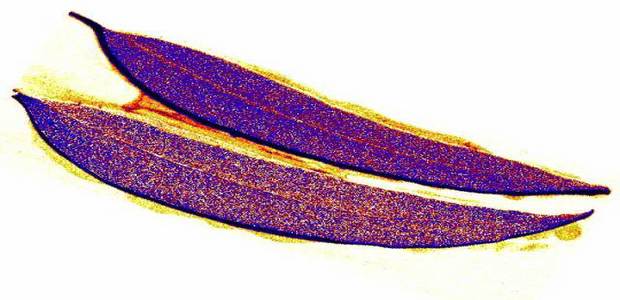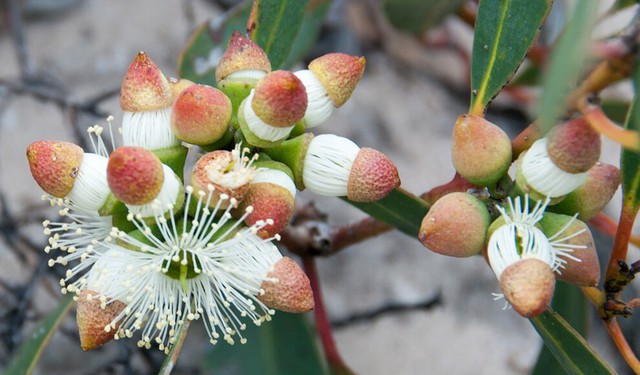Why is eucalyptus called “gold sucker”? Long-term scientific research shows that the secret lies in the part buried deep underground
According to the World Gold Council, more than 174,000 tons of gold have been extracted from the earth since the beginning of civilization. In 2011, the United States Geological Survey estimated that 51,000 tons of gold are still stored on our planet.
As the first metal discovered by man, gold occupies a central place in human history. At the present time, gold is still one of the factors that govern the world economy as well as the lives of each individual.
The mining of gold is one of the topics of interest when the reserves of this metal are gradually decreasing. However, in a study nearly a decade ago, scientists found gold stored in trees. The identity of that tree made people even more surprised.
FINDING GOLD IN THE FRUIT
Australian researchers have discovered that microscopic gold particles from underground ore deposits are present in the leaves of eucalyptus trees. Most plants are deeply rooted in the Earth, sucking up the nutrients and minerals necessary for life. Therefore, many theories suggest that in the process, the tree accidentally “suck” gold.
Eucalyptus tree roots can dig more than 40 meters underground. This plant can root deep into the ground in search of water in arid regions, even breaking into gold-rich regions, where they absorb microscopic metal particles as they take in water and nutrients.
The Nature Communications report, led by a team led by Melvyn Lintern of Australia’s CSIRO Earth Science and Resource Assessment science agency, offers an answer to this phenomenon. Until now, however, researchers were uncertain whether the trees could actually absorb the precious metal from underground sediments or simply wind blowing the gold dust there from other locations.
CHECK THE TRUTH
To test whether eucalyptus trees can “suck” gold, the researchers investigated the leaves, branches and bark of eucalyptus trees up to 10 meters tall from two locations in Australia – one in the west, one in southern. Previous exploratory drilling has revealed that these sites have gold buried underground. This place is not disturbed by gold mining activities, so the possibility of gold dust left on the leaves can be ruled out.

They also planted eucalyptus trees in a greenhouse with a potting soil doped with gold, as well as in a normal pot with no gold for comparison.
X-ray analysis revealed gold particles up to 8 microns wide in cells from the plants, or about 10 times thinner than the average human hair. Field samples and greenhouse experiments show that these gold particles – present in concentrations that are not harmful to the plant – are absorbed by the roots and transported to its parts. In which, the leaves of the trees have the highest concentration of gold.
The average concentration of gold in leaves is only about 46 parts per billion, equivalent to 0.000005% of the weight of each leaf.
Lead author of the study, Melvyn Lintern, a geochemist at the Commonwealth Scientific and Industrial Research Organization in Australia, said: “We were surprised at the ability to bring gold from [chiều cao] equivalent of a 10-story building in a eucalyptus tree”.
The researchers do not suggest mining these eucalyptus trees for gold, Lintern warns: “The amount of gold in the tree is extremely small. It is estimated that it takes 500 eucalyptus trees to have enough gold to make one. ring”.
However, this discovery is still highly appreciated by experts for its potential. Instead of being a gold miner, the eucalyptus tree can help miners locate possible locations deep within a gold mine and thus avoid wasting time, money and resources searching for the metal. precious over large tracts of land, Lintern said.
LITTLE FACTS ABOUT THE eucalyptus tree
Not only has the effect of “gold-sucking tree”, eucalyptus is also a tree with many strange characteristics. Here are some interesting facts about this familiar plant:
Eucalyptus flower without wings
From a distance, the flowers on most eucalyptus trees look like clusters of dandelions about to seed. Up close, you’ll see these flowers have no petals. An entire “flower” is essentially a collection of hundreds of stamens growing from a central cone-like bud.
Eucalyptus trees need to use as much pollen as possible. They have few natural pollinators because of their high concentration of cineole. Usually, this plant is self-pollinating.

Cineole: The Secret Ingredient
Eucalyptus essential oil has been used in Australian Ayurvedic medicine as an antibacterial and antifungal agent for centuries. In Indian medicine, it is commonly used to treat respiratory ailments. In 17th century England, eucalyptus essential oil was used to disinfect hospitals.
Because the leaves and bark of the plant contain high levels of cineole. Cineole is a colorless, liquid organic compound. It is also sometimes called eucalyptol because it is abundant in eucalyptus trees and shrubs. The aroma of eucalyptus is mainly that of cineole.
Only koalas, marsupials, and some insects can eat eucalyptus leaves and bark. No other organism, including humans, can tolerate high levels of cineole. That is why it becomes an effective and natural insect repellent.
Clinical research has demonstrated the anti-bacterial, antiseptic, and anti-fungal properties of cineole. Eucalyptus essential oil is particularly effective in topical wound treatment, skin care, and sterilization.
Eucalyptus trees contribute to reducing the incidence of malaria
Because the leaves have essential oils that repel insects, eucalyptus is grown in areas with high malaria rates.
Malaria is a disease found on every continent. Malaria parasites live in female mosquitoes that bite humans and are transmitted to humans when they bite. In areas of the world with high numbers of malaria-carrying mosquitoes, eucalyptus trees have been adopted to help reduce this problem.
Eucalyptus trees can help manage wastewater problems
For many years, scientists have been working to use eucalyptus to reduce wastewater problems. In some parts of the world, wastewater carrying heavy metals, bacteria and other toxins into groundwater is a concern for agriculture.
Environmental engineers and agro-forestry experts plant eucalyptus trees in contaminated sites. There is a lot of evidence that eucalyptus trees absorb and filter many harmful elements present in the water used for plants.
While more research is still needed to know the right balance of these trees for farmland, experts say this is a promising and viable solution.
Synthetic
at Blogtuan.info – Source: cafebiz.vn – Read the original article here



